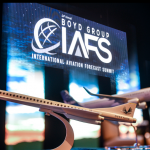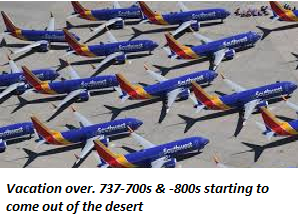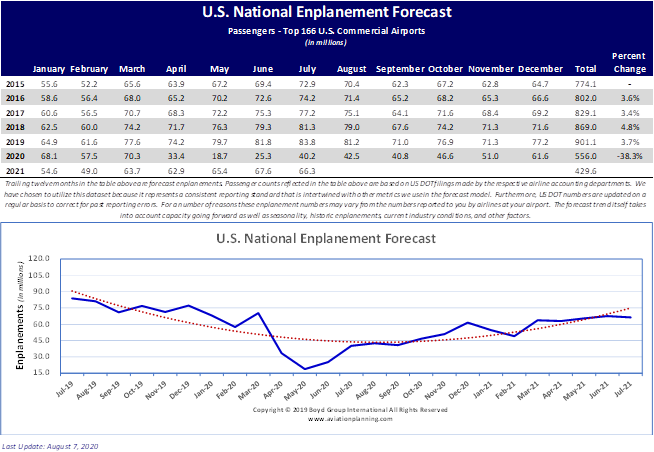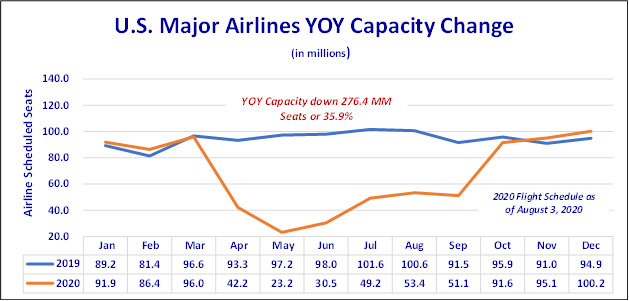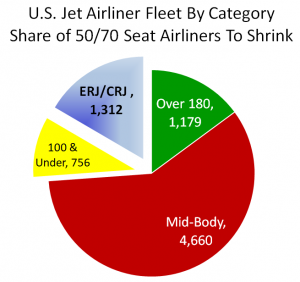Impulse Air Cargo – The Next Trend In Logistics
Time is the new major cost component of 21st century business.
The old adage that “time is money” is coming into its own in communications and distribution.
Just as new electronic modes of transferring data and information have decimated much of what was once vibrant intra-regional and short-haul passenger volume, the new imperative of speed and accuracy in logistics are going to propel a new dynamic in air cargo. The value of time is increasing rapidly in all aspects of global and domestic business.
At the 25th International Aviation Forecast Summit, October 11-13, we’ll be discussing the the coming explosion in the role and importance of air cargo transportation in the USA and across the globe
For the first time in history, the role of air cargo as a key logistics modality is breaking out of its traditional role of carrying traditional specific high-value, time sensitive categories of goods.
 Regardless of the sector – in the next five years, the role of air freight as part of our communications system will expand. Airports that understand and anticipate this will be in line for some entirely new traffic.
Regardless of the sector – in the next five years, the role of air freight as part of our communications system will expand. Airports that understand and anticipate this will be in line for some entirely new traffic.
This is despite the fact that air logistics are much more expensive than surface modes. That’s a value-factor that’s changing… reason? Time value is the new imperative in global and domestic trade.
Take it to the bank… the emerging key component of the future communication channels will be time-value. It is now staring to eclipse the natural higher expense of levitating things in airplanes to get from point A to point B. It is going to affect all sectors of air cargo.
Along With This, The Emergence of A New Air Cargo Genre. Anyone who took Marketing 101 knows what an “impulse item” is. It’s products that are positioned to get the consumer to buy it, as the term indicates, on impulse.
They see it and find it’s really easy to reach out and get it. Typically these are items found, for example, along check-out counters at supermarkets. It takes no effort or hassle to just reach out and grab that candy, or whatever else is there. Quick decision, quick gratification.
Today, Amazon has turned much of the entire retail business into a sea of “impulse items.” Now, it’s easy to just go on line, hit a couple of keystrokes, and voila! the item is on its way for delivery as fast as tomorrow – which is competitive or better than going to the mall and all the hassle. Because it’s easy – even if it’s a couple days delivery – the access to the product is just like at the supermarket check out counter… ‘Cept it’s for millions of items.
The economics created by the sheer volume of sales is increasingly supportive of air transportation. Historically, shipping things by air was relegated to high-value items that demanded fast transport from manufacture to end-use. The Amazon model delivers huge volumes of mostly small items, and increasingly they can be aggregated into flights focused on customer deliveries to specific geographic areas.
 Now, add to this the increased value of time in all communication channels, and air cargo – in a number of formats, not just the impulse sector – will become far more important
Now, add to this the increased value of time in all communication channels, and air cargo – in a number of formats, not just the impulse sector – will become far more important
Recipe: A 737-Capable Runway. A Secure Ramp. Good Surface Access to Final Users. This impulse model opens up dozens of U.S. airports to substantial new opportunities. This includes those with no current passenger service. Actually, these airports may have an advantage. The Amazon impulse air cargo model is likely to expand – and beyond just Amazon, and also in various iterations of the approach. But so are other sectors of air cargo. Air logistics represent speed… and time reduction will be an increasing part of what will make a lot of commodities more competitive.
The message is clear: air cargo is fixin’ to launch beyond its traditional barriers. At the International Aviation Forecast Summit, October 11-13 at Cincinnati USA, we will have presentations from senior executives from Atlas Air and DHL. These are cutting-edge companies that have some new ideas on where the business of transferring goods by air – including across the globe – will be evolving. Get the straight facts and perspectives – and get ahead of the competition.
If you haven’t registered yet, click here to go to the IAFS website and to reserve your space. And take a look at the agenda, too – when this event wraps up, you’ll have a much clearer perspective of the new aviation industry.
_________________________
The Airport & Airline Industries Need To Start Swinging Back
More Bogus CCP-Covid Reports On “Dangers” of Air Travel
Does anybody actually question the stuff that gets reported about air travel and the CCP-Covid pandemic?
It doesn’t seem like it, particularly if it might counter herd thinking and political-correctness.
Every Famous Person Is Now An Expert. It seems that just about anything that any semi-sober source puts out about the disease is taken at face value – whether it’s from a medical laboratory someplace in England that turns out to have three employees and zero experience, a questionable and obvious ax-grinding “expert” on one network or another referencing “unnamed” sources, an industrialist whose claim to fame has zip to do with medical issues, or the second-runner-up for worst actor at the Oscars.
All have credibility, apparently.
Airline Cabins Designed By Typhoid Mary. Just in the past couple of weeks, more panting stories have come out about how the disease can be transmitted easily in an airplane cabin.
It’s the latest news, don’t ya know, notwithstanding they were from research on just a couple of flights that parked at the gate almost six months ago, when none of the current and extensive sanitation precautions had been implemented.
These jive reports tag on to the misleading CDC report of about a month ago, regarding how they implied that an airliner cabin was the equivalent of a giant Petri dish. They took data from two flights… just two. They didn’t note clearly that these flights – again, six months ago – were both charters evacuating people from highly-infected areas in Italy back to Korea.
But, like good little politically-correct sheep, that critical point was missed in regard to the value of the CDC report as a news story.
The latest reports – one from research in Vietnam, even – advises us that CCP-Corona-19 can be spread on long-haul flights. They actually reviewed and tracked passengers on two flights between Europe and Asia.
But these, too, were flights that took place in March. And they’re reporting it now, as if it’s current data, implying that it is relevant to the current state of air travel.
When These Flights Operated, The Politicians Were Denouncing Claims of Contagion. Back then, not only were there no precautions anywhere near the now-increased (and, hyper) sanitation at airports and airlines, but take a gander at what our own politicians were telling us at the same time about the CCP-Covid disease.
To put these “reports” in context, these supposed red-flag flights took place at a time frame when the Mayor of New York was telling folks not to worry, as the disease wasn’t airborne-communicated, and the city was in great shape to handle the situation. Out West, the speaker of the House of Representatives was doing photo-ops, almost shaming people for not participating in festivities on the streets of San Francisco.
The point is that “studies” of the vulnerability of air travel to the CCP-Covid disease from March and earlier are completely inaccurate when comparing it with air travel is today.
Spit Out Numbers – And Provide No Context. It’s More Exciting That Way. Then there was a recent statistic that since March, the TSA reports that 1,875 TSA staff have been infected, noting that most were screeners. Yup, that’s because most TSA staff are screeners.
Other referenced data is that the TSA currently has 215 CCP-Covid infected employees (out of that 1,875) with the inference that the infection rate makes working at the Transportation Security Administration nearly as dangerous as inviting a family of crocodiles over for cocktails.
Does anybody even try to put these numbers into context? That number of currently-infected staff – 215 – represents three tenths of one percent of all TSA employees, and there is the dishonest inference in some of these outside “reports” that they only could have gotten it on the job. There are probably a lot more lost work hours due to occupational injuries or other day-to-day maladies, than what’s being inflicted by the CCP-Covid pandemic.
Got Some Notoriety? You’re A CCP-Covid Expert. The problem that the airline industry faces is the current swirl of supposed “expert” information, coming from all directions.
Last week, Bill Gates – obviously an expert in disease transmission and what went on at the Wuhan Virology facility and elsewhere in China – announced that that the prohibition of China-U.S. traffic actually helped spread the disease. His opinion, with zero attempt to question the assumptions, has been published as if it came direct from Zeus’s chiropractor on Mount Olympus.
No questions asked, the media just reported it. It came from Bill Gates, right?
Political Correctness Is Very Expensive. If we are to get air traffic volume to mirror the rest of the national recovery, the airport industry and the airline industry need to fill this information void, and come back like lightning when misinformation such these on-board infection reports come out.
It makes no difference if they come from the CDC, or a lab in some far-off country, or actors and philanthropists spouting off on subjects they know little about.
Aviation industry organizations need to swing back when misinformation is taken as fact.
At this point, that’s going to be a lot of punches that need to be thrown, and it likely will offend some folks.
Tough. This is business.
______________________
